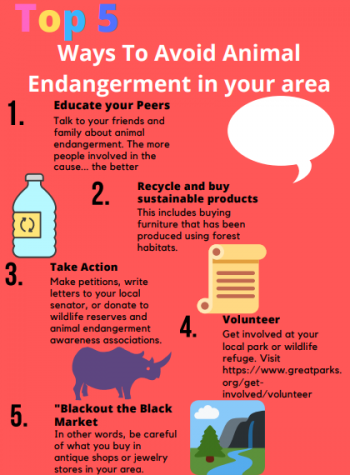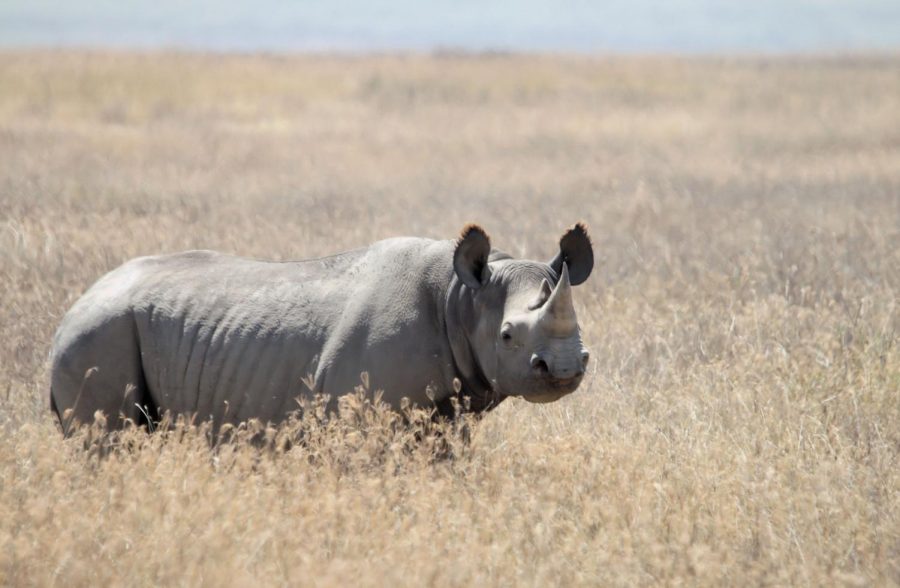A horn in society’s side
New, fake rhinoceros horn seeks to reduce poaching and black market sales, helping the endangered Black Rhino species
Animal endangerment is inflicted in many ways. There is a long list of possible causes for this species decline on our planet, such as climate change, droughts, violent storms and other natural causes.
But while snakes slither on the ground and elks gallop in the wind, humans set out to alter the world’s ecosystems just for monetary benefit, and in doing so, they potentially placed another threat on the animal population’s safety.
The Black Rhinoceros, native to eastern and southern Africa, is a prime example of the darkness lurking in the savannah. They are listed as “critically endangered.” Seeing one in the wild is a rarity of its own. The reason for this endangerment is the rhino’s horn. Their horns, made of keratin and small tightly packed hairs coming from the nose and excretions from the glands, are estimated to be worth $65,000 on the Asian black market.
This lucrativeness causes people to extract the horn, commonly through poaching. The World Book Encyclopedia defines poaching as being “illegal hunting or capturing of wild animals, usually associated with land use rights.”
Jason Gilchrist, an ecologist at Edinburgh Napier University and writer for The Conversation referenced the accessibility of Rhino Horns in areas where the business thrives the most. “It’s easy to see why South African game farms would support a legal trade. Rhino horns can be harvested without having to kill the animal, many farms have stockpiles, and farms want to cash in on their stock.”
However, scientists are now developing a fake rhino horn that they hope will dominate the market and reduce the need to use real rhino horns, possibly decreasing the killing of the animal for easier accessibility and depriving it of one of its most essential extracorporeal body parts. The horn acts just like the original rhino horn when cut or shaved for multiple uses.
To create this proxy horn, the researchers used hairs from horses, the rhino’s closest relative. Like our own hair, these strands are scaly, while the rhino’s are smooth, so they used lithium bromide to chemically etch away the horsehair’s rough outer layer.
According to a Rhino awareness website, Save the Rhino, rhino horns are used by many foreign cultures for a variety of reasons. In China, It is used as a “traditional Chinese medicine,” made from horns shaved/ground into a very fine powder.
In Vietnam, rhino horns are used in two ways: as a sort of hangover cure and treatment for terminal illnesses. Another health-related reason has a more symbolic meaning than a physical treatment.
According to The New York Times, Lynn Johnson, founder of Nature Needs More, conducted an experiment in which she interviewed 20 Vietnamese citizens about the current state of the rhino horn market.
“A 2018 study involving 30 Vietnamese rhino horn buyers found that most no longer believed it could cure cancer — a newfangled use that became popular around a decade ago — but they still sought it out as a symbolic final gesture to comfort terminally ill relatives,” Johnson said.

Recently, studies have been conducted to show that the horns are not so much for health as they are for status, targeted towards wealthy men. This idea of using the rhino horn as a status symbol is derived from the horn’s exclusivity, high price and rarity.
“Every conservation organization working in Asia, both the international ones and the Asian organizations, are working on demand reduction, trying to educate people not to use rhino horns. If it’s medicinal, you can use something else. And if it’s a status symbol, just don’t,” said Jon Taylor, deputy director of Save the Rhino International.
There are also many negative outcomes of this faux horn that could ensure the backfire of any attempts to reduce the rhino’s endangerment. It could confuse buyers on the black market and only fuel them to want to go get their own horns. This means that the fake rhino horn, made of horsehair, could potentially increase the market, rather than decrease it. Needless to say, scientists are still on the fritz on whether or not they should put the faux rhino horn in full action.
“If you introduce quality uncertainty into the market, you are trying to create confusion and essentially destroy the rhino horn market,” Fredrick Chen, an economist at Wake Forest University, wrote for The New York Times.
The black market is solely dependent on the consumers of the products, so whether or not you are for or against the fake rhino horn, it is agreed that the simplest way to avoid animal endangerment is to just not buy accessorized animal products.
Your donation will support the student journalists of Walnut Hills High School. Your contribution will allow us to purchase equipment, cover our annual website hosting, printing costs and offset competition and conferences fees for students.








